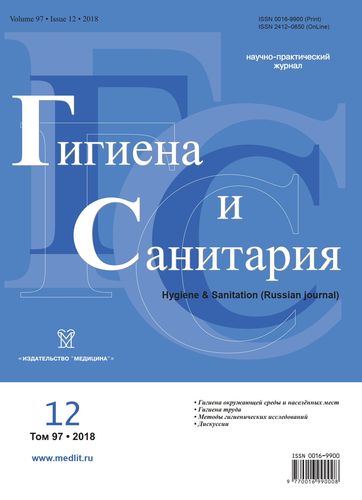Peculiarities of monitoring for infrasound pollution of residential areas located in proximity to highways
- Authors: Kuznetsova E.B.1, Bulavina I.D.1
-
Affiliations:
- North-West Public Health Research Center
- Issue: Vol 97, No 12 (2018)
- Pages: 1141-1145
- Section: ENVIRONMENTAL HYGIENE
- Published: 21.10.2020
- URL: https://ruspoj.com/0016-9900/article/view/640445
- DOI: https://doi.org/10.47470/0016-9900-2018-97-12-1141-1145
- ID: 640445
Cite item
Full Text
Abstract
Introduction. Procedural provision of studies on monitoring for infrasound pollution of residential areas located in proximity to highways is the issue of the consideration in this article. The fact of the absence of a standardized procedure for carrying out large-scale studies of the infrasound range of the sound pressure in residential areas is reported. A brief review of regulatory documents currently used by experts of accredited laboratories, hygiene and epidemiology centers to solve sanitary problems of infrasound range acoustics, is given.
Material and Methods. As a rule, experts use techniques for a hearing range of noise measurements and procedures specified by device service instructions which result in significant inconsistencies of research findings. Determination of parameters affecting the accuracy of research findings carried out with the help of routine devices available in hygiene and epidemiology centers was the objective of infrasound measurements presented here.
Results. Effect of wind flows, study duration and monitoring location point were found to be the major parameters affecting the accuracy of research findings. Data on wind load on Saint-Petersburg territory is reported. Territories in the immediate proximity to the “West Speed Diameter” (WSD) highway, Ring motorway and Sinopskaya embankment being potential infrasound sources, were chosen for experimental studies. Such choice was caused by the heavy freight and passenger car traffic characterized by relatively permanent intensity.
Discussion. Measurement series at various wind loads and of different durations were done. Measurement points were chosen in free field and in the vicinity of echoing areas. Measurement data were assessed taking into account expanded uncertainty, at 95% confidence level. It was found that reliable measurement results in infrasound frequency range can be obtained on the territory at wind velocity not exceeding 1 m/sec, during measurements in the free sound field with duration over 20 minutes. Given wind load conditions can be realized in St.-Petersburg for several days a month.
About the authors
Elena B. Kuznetsova
North-West Public Health Research Center
Author for correspondence.
Email: sound_kuzn@mail.ru
ORCID iD: 0000-0002-1573-5021
MD, junior researcher of the Department of Complex Hygienic Assessment of Physical Factors of the North-West Public Health Research Center, Saint-Petersburg, 191036, Russian Federation
e-mail: sound_kuzn@mail.ru
Russian FederationI. D. Bulavina
North-West Public Health Research Center
Email: noemail@neicon.ru
ORCID iD: 0000-0002-0516-7390
Russian Federation
References
- Zinkin V.N., Soldatov S.K., Bogomolov A.V., Dragan С.P. Current problems of population protection against low frequency and infrasound noise. Tekhnologii grazhdanskoi bezopasnosti. 2015; 12 (1(43)): 90-96.
- Grafkina M.V., Nyunin B.N., Sviridova E.Yu., Ral’chenko V.I. Ambient infrasound fields of land-based vehicles. Izvestiya Moskovskogo gosudarstvennogo tekhnicheckogo universiteta MAMI. 2013; 1 (2(16)): 45-48.
- Goncharenko B.I. Admissible noise levels in low and infrasound frequency ranges. Mir Izmerenii. 2012; (3): 19-24.
- МИ ПКФ-14-016. Procedure for sound pressure measurement in infrasound frequency range at workplaces in workshops and on the territory. Razrabotchik OOO NPF “ElectronDizain”. Zaregistrirovana v Fedral’nom informatzionnom Fonde po obespecheniyu edinstva izmerenii Rosstandarta No FP.1.36.2014.18773.
- Zinkin V.N., Dragan S.P., Akhmetzyanov I.M., Orikhan M.M. Organizational and procedural basis for infrasound monitoring at manufacturing enterprises. Ekologiya promyshlennogo proizvodstva. 2014; 86 (2): 54-60.
- Torkunova O.V., Shibanov P.D. Pharmacological correction of unfavourable effect of low-frequency acoustical oscillations. Obzory po klinicheskoi farmakologii I lekarstvennoi terapii. 2014; 12 (3): 20-25.
- Myagkov M.S., Alekseeva L.I. Peculiarities of wind regime in typical urban residential area. Arkhitektura I sovremennye informatzionnye tekhnologii. MARKhI. Elektronnyi zhurnal. 2014; 1 (26): 26/14-04.
- European Guidelines on night noise control. World Health Organization. European Regional Bureau. 2014. ISBN 978 92 890 5012 8.
- Zuev A.V., Fedotova I.V., Vasil’eva T.N., Nekrasova M.M. Infrasound effect on acoustical environment of residential area. Bezopasnost’ i okhrana truda. 2018; (1(74)): 38-40.
- Zinkin V.N. Industrial enterprises and transport as sources of low frequency noise and infrasound: Control and prevention of adverse effect. Bezopasnost’ v teknosfere. 2016; 5 (2):35-42.
Supplementary files









